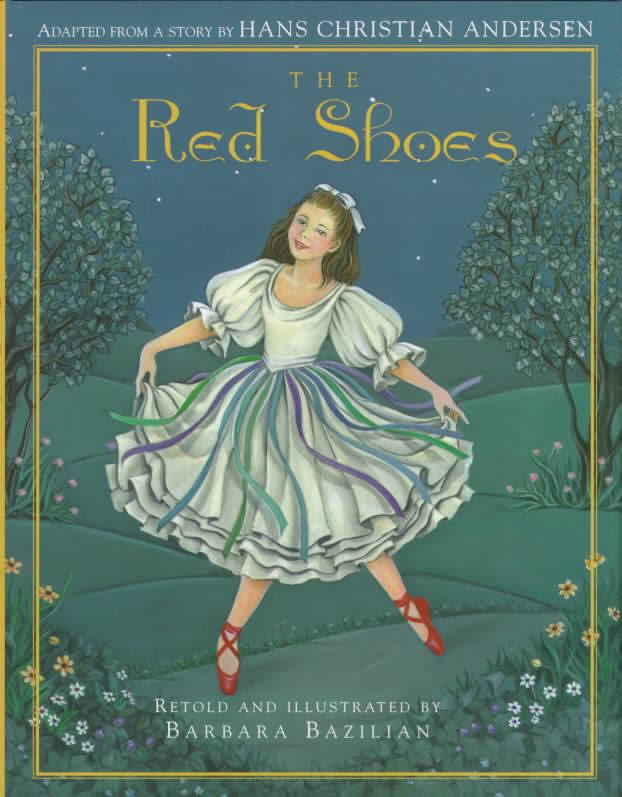Original title De røde sko Publication date 7 April 1845 Originally published 7 April 1845 Genre Fairy tale | Media type Print Publisher C.A. Reitzel | |
 | ||
Similar Works by Hans Christian Andersen, Fairy tale books, Other books | ||
"The Red Shoes" (Danish: De røde sko) is a fairy tale by Danish poet and author Hans Christian Andersen first published by C.A. Reitzel in Copenhagen 7 April 1845 in New Fairy Tales. First Volume. Third Collection. 1845. (Nye Eventyr. Første Bind. Tredie Samling. 1845.). Other tales in the volume include "The Elf Mound" (Elverhøi), "The Jumpers" (Springfyrene), "The Shepherdess and the Chimney Sweep" (Hyrdinden og Skorstensfejeren), and "Holger Danske" (Holger Danske).
Contents
The tale was republished 18 December 1849 as a part of Fairy Tales. 1850. (Eventyr. 1850.) and again on 30 March 1863 as a part of Fairy Tales and Stories. Second Volume. 1863. (Eventyr og Historier. Andet Bind. 1863.). The story is about a girl forced to dance continually in her red shoes. "The Red Shoes" has seen adaptations in various media including film.
Plot summary
A peasant girl named Karen is adopted by a rich old lady after her mother's death and grows up vain and spoiled. Before her adoption, Karen had a rough pair of red shoes; now she has her adoptive mother buy her a pair of red shoes fit for a princess. Karen is so enamored of her new shoes that she wears them to church, but the old lady scolds her: it's highly improper and she must only wear black shoes in church from now on. But next Sunday, Karen cannot resist the urge to put the red shoes on again. As she is about to enter the church, she meets a mysterious old soldier with a red beard. "Oh, what beautiful shoes for dancing," the soldier says. "Never come off when you dance," he tells the shoes, and he taps the sole of each with his hand. After church, Karen cannot resist taking a few dance steps, and off she goes, as though the shoes controlled her, but she finally manages to take them off. One day, after her adoptive mother becomes ill, Karen leaves her alone and goes off to a ball in town in her red shoes. She begins to dance, but this time the shoes won't come off. They continue to dance, night and day, rain or shine, through fields and meadows, and through brambles and briers that tear at Karen's limbs. She can't even attend her adoptive mother's funeral. An angel appears to her, bearing a sword, and condemns her to dance even after she dies, as a warning to vain children everywhere. Karen begs for mercy but the red shoes take her away before she hears the angel's reply. Karen finds an executioner and asks him to chop off her feet. He does so but the shoes continue to dance, even with Karen's amputated feet inside them. The executioner gives her a pair of wooden feet and crutches, and teaches her the criminals' psalm. Thinking that she has suffered enough for the red shoes, Karen decides to go to church so people can see her. Yet her amputated feet, still in the red shoes, dance before her, barring the way. The following Sunday she tries again, thinking she is at least as good as the others in church, but again the dancing red shoes bar the way. Karen gets a job as a maid in the parsonage, but when Sunday comes she dares not go to church. Instead she sits alone at home and prays to God for help. The angel reappears, now bearing a spray of roses, and gives Karen the mercy she asked for: her heart becomes so filled with sunshine, peace, and joy that it bursts. Her soul flies on sunshine to Heaven, where no one mentions the red shoes.
Background
Andersen explained the origins of the story in an incident he witnessed as a small child. By his report, his father was sent a piece of red silk by a rich lady customer, to make a pair of dancing slippers for her daughter. Using red leather along with the silk, he worked very carefully on the shoes, only to have the rich lady tell him they were trash. She said he had done nothing but spoil her silk. "In that case," he said, "I may as well spoil my leather too," and he cut up the shoes in front of her.
